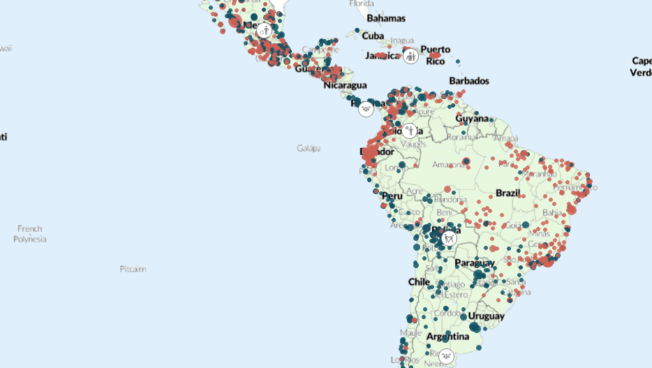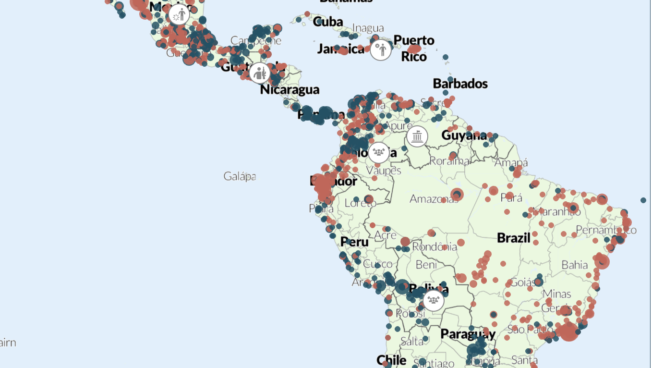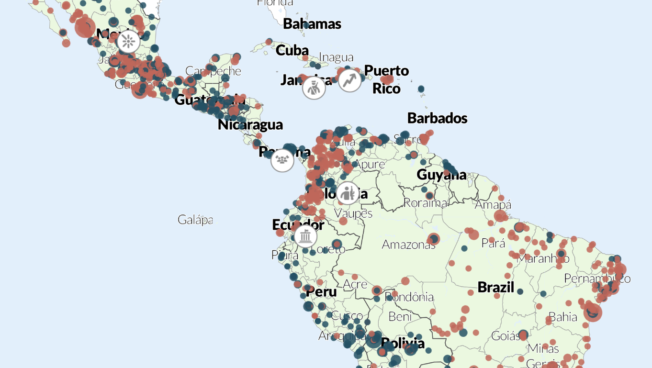Regional Overview
Latin America and the Caribbean
July 2025
Posted: 4 July 2025
In this Regional Overview covering June 2025
- Argentina: A Supreme Court ruling against former President Fernández de Kirchner sparks protests
- Bolivia: Clashes between Evo Morales supporters and security forces turn deadly
- Colombia: The shooting of a presidential hopeful reignites fears of political violence ahead of elections
- Haiti: The Viv Ansanm gang coalition expands its offensive outside Port-au-Prince
- Mexico: Violence against political figures increases in Michoacán and Veracruz
- Panama: Protests against the Social Security Fund intensify in Bocas del Toro province
Argentina: A Supreme Court ruling against former President Fernández de Kirchner sparks protests
On 10 June, the Supreme Court upheld a 2022 verdict against former President Cristina Fernández de Kirchner. The verdict mandated a six-year prison sentence and a lifelong ban from public office on corruption charges.1Almudena Calatrava and Débora Rey, “Argentine Supreme Court upholds 6-year prison sentence for ex-President Fernández,” The Associated Press, 11 June 2025 The ruling came just days after Fernández de Kirchner announced her intention to run in the Buenos Aires provincial elections scheduled for September. She claimed that the court was putting a clamp on the popular vote.2Perfil, “Cristina Kirchner after the Supreme Court ruling: ‘It’s a triumvirate of disgraceful individuals,’” 10 June 2025 (Spanish) It also prompted at least 54 protests across the country, spearheaded by Justicialist Party sympathizers. These protests accounted for over one-third of the total demonstrations recorded in June and contributed to a 31% increase in demonstrations compared to May. The biggest march took place in Buenos Aires on 18 June — a day after Fernández de Kirchner began serving her sentence under house arrest.3Nicolás Misculin, “Thousands march in Buenos Aires as ex-president Kirchner starts house arrest,” Reuters, 18 June 2025 The Supreme Court ruling fractured the political debate between those hailing it as a blow to corruption and those who consider it political persecution. It may remain a key issue in the political debate as the country approaches the October 2025 legislative elections, likely leading to further mobilizations.
Bolivia: Clashes between Evo Morales supporters and security forces turn deadly
Political tensions over former President Evo Morales’ exclusion from the presidential race in the upcoming 17 August elections escalated this month. In June, ACLED records at least 135 protests by Morales sympathizers, including massive roadblocks for 15 consecutive days, predominantly in Cochabamba, the former president’s political stronghold.4Deutsche Welle, “Evistas radicalize protests with blockades in Bolivia,” 3 June 2025 (Spanish) This accounts for around two-thirds of the demonstrations in the whole country and contributed to a 55% increase in protests in June compared to May. While most demonstrations were peaceful, residents who rejected the blockade clashed with Morales supporters in Llallagua, Potosí, leaving at least 30 people injured. Following these confrontations, the government deployed police and military forces to clear the roads in different parts of the Cochabamba and Potosí departments. This prompted various clashes between police and Morales supporters, which left four officers and two civilians dead.
Although Morales had previously — and most recently in May — mobilized his supporters to challenge the December 2023 constitutional court ruling that barred him from seeking a fourth term, this was the deadliest confrontation during demonstrations that ACLED records since the post-2019 election crisis that resulted in Morales being removed from power.
Colombia: The shooting of a presidential hopeful reignites fears of political violence ahead of elections
On 7 June, a 14-year-old hitman shot Senator Miguel Uribe Turbay during a rally in western Bogotá, severely injuring him.5Human Rights Watch, “Colombia: Presidential Candidate Attacked, Severely Injured,” 10 June 2025 The attack occurred just a few weeks into his campaign to become the Democratic Center (CD) presidential candidate. This marked the first targeted assassination attempt of a high-level Colombian politician since 1995, bringing back memories of the most high-profile political attacks that afflicted the country in the 1980s and 1990s.6The Guardian, “Assassination attempt in Colombia spark fears of return to bloody past: ‘It’s a devastating moment,’” 13 June 2025
The attack triggered a wave of protests in solidarity with the opposition politician, who is a vocal critic of President Gustavo Petro.7International Crisis Group, “Assassination Attempt on Top Politician Stirs Colombian Anxieties,” 9 June 2025 In the weeks following his shooting, ACLED records at least 36 protests in support of Uribe Turbay in 22 cities across 16 departments, led by his conservative CD party. The largest protest took place on 15 June in Bogotá, where over 70,000 people marched, accusing Petro of exacerbating polarization in the country8W Radio, “Did the silent march also express rejection of the Petro government? Debate in Congress,” 16 June 2025 (Spanish) and calling for the defense of democracy.9Infobae, “‘Petro out’: The chant rang out once again, this time during the March of Silence following the attack on Miguel Uribe,” 15 June 2025 (Spanish)
The assassination attempt, coupled with high-impact events of violence in the Valle del Cauca and Cauca departments, highlights the multitude of security concerns facing the country. On 10 June, a string of explosions and attacks by FARC dissidents rocked the Cauca and Valle del Cauca departments.10France 24, “Colombia: Five civilians and two police officers killed in explosive attacks in two departments,” 10 June 2025 (Spanish) A few days later, locals temporarily retained 57 soldiers in El Plateado, Cauca, likely under pressure from FARC dissidents. This mix of events has placed security and political violence at the forefront of the political debate leading to the 2026 presidential elections.
Haiti: The Viv Ansanm gang coalition expands its offensive outside Port-au-Prince
Gangs reduced their activities, particularly in Port-au-Prince, but continued to expand their reach outside the capital. With 37 reported events, gang-related violence decreased for the second consecutive month, dropping by 45% in June compared to the month prior. Deadly anti-gang operations, often supported by drone strikes, seem to have increased pressure on gangs. Between 9 and 10 June, security forces launched drone strikes in the Village de Dieu and Grand Ravine neighborhoods in Port-au-Prince, killing at least 100 people. On 15 June, police, supported by self-defense groups, killed at least 20 gang members during clashes in Kenscoff.
Despite these efforts, gangs’ territorial expansion in the capital and beyond remained largely unaffected. For example, on 22 June, Viv Ansanm gang members seized control of La Chapelle in Artibonite, an area previously spared from violence. During an early morning incursion, they attacked the local police station and blocked roads to hinder state intervention. The action also forcibly displaced around 9,000 residents.11Alterpress, “Gang attack in La Chapelle: 6 dead, nearly 9,000 displaced, according to the IOM,” 26 June 2025
As operations fail to dismantle gang leadership and stop incursions, public frustration over insecurity continues in the country. In June, ACLED records at least nine demonstrations, mostly in the Artibonite and Centre departments, where protesters demanded that authorities take more decisive action to combat gangs. One of these protests in Peligre, Centre, turned violent on 17 June, as residents shut down the hydroelectric power plant, causing massive blackouts in the capital, Port-au-Prince.12Emmanuel Marino Bruno, “Haiti: Péligre hydroelectric power plant shuts down again, Port-au-Prince metropolitan area plunged into blackout,” Alterpresse, 18 June 2025 (French) These demands come amid political frictions within the transitional authorities and growing uncertainty over the future and funding of the Kenya-led Multinational Security Support Mission.
Mexico: Violence against political figures increases in Michoacán and Veracruz
In June, targeted attacks against political figures reached their highest levels in 2025, with almost 50 events. This wave of violence resulted in the killing of at least 25 politicians and collaborators, including three mayors. Several high-profile attacks occurred in Michoacán state, including the targeted killings of mayors in Tacámbaro and Tepalcatepec, as well as attacks by criminal gangs on Tingüindín city hall and the municipal palace of Benito Juárez. Some of these incidents may be related to disputes between the Jalisco New Generation Cartel (CJNG) and local criminal groups, or to CJNG retaliation following security operations targeting its local cartel leaders.13La Jornada, “Drug lord’s arrest triggers roadblock in Tierra Caliente, Michoacán,” 26 June 2025 (Spanish); Diego Mendoza López, “This is how authorities have responded to the violence between the CJNG and La Familia Michoacana in Zitácuaro,” Infobae, 21 June 2025 (Spanish) The assassinated mayor of Tepalcatepec was the sister-in-law of a leader of the United Cartels group, which the CJNG has been fiercely fighting with in recent months.14Aura Reyna, “From rancher to rival of the CJNG, he is ‘El Abuelo Farías,’ alleged brother-in-law of the murdered mayor of Tepalcatepec,” Infobae, 23 June 2025 (Spanish)
Violence against political figures also grew in Veracruz, where judicial and local elections were held on 1 June. During election day and the following week, rioters damaged ballots, vandalized polling stations, and attacked electoral officials in at least 10 municipalities amid claims of irregularities and the rejection of electoral results.15Francisco de Luna, “After the elections, there were riots in 7 municipalities of Veracruz,” E-consulta.com, 2 June 2025 (Spanish) In May and June, before and after the election, ACLED records at least 40 events of violence targeting political figures in Veracruz, even more than in May and June 2021, when the state held the latest local elections.
Panama: Protests against the Social Security Fund intensify in Bocas del Toro province
In June, police intervention in protests, roadblocks, and violent demonstrations related to the reform of the Social Security Fund increased, particularly in the Bocas del Toro province, despite a nationwide decrease in demonstrations compared to May. Demonstrations in Bocas del Toro have been building since May, amid a general labor strike led by banana workers that prompted the transnational banana company Chiquita Brands to suspend operations and lay off 6,500 workers.16Elida Moreno, “Chiquita Panama to Lay Off Remaining Workers After Staff Exit from the Country,” Reuters, 3 June 2025 (Spanish) The mobilization continued even after the banana workers’ union reached an agreement with local authorities to lift the roadblocks and end the strike in exchange for a new law approved by Congress on 14 June that increased worker benefits in the sector.17Alma Solís, “Panama’s Assembly approves a law for the banana sector two days after the strike ended,” The Associaled Press, 14 June 2025 (Spanish)
In response, the government deployed over 2,500 police officers to clear the roads and extended a previously declared state of emergency on 20 June. The crackdown led to the arrest of 304 people — at least 90 of whom the government claimed are suspected gang members who infiltrated the demonstrations — and the death of one protester.18TRT Global, “What’s happening in Panama’s Bocas del Toro province, and why is the ‘state of emergency’ being extended?” 25 June 2025 (Spanish) In June, 13 of the 16 recorded demonstrations in Bocas del Toro involved clashes between rioters and police. Some also involved the looting of public and private facilities, including the local airport, stadium, and Chiquita’s offices in Changuinola.
See More
See the Codebook and the User Guide for an overview of ACLED’s core methodology. For additional documentation, check the Knowledge Base. Region-specific methodology briefs can be accessed below.
Links:







